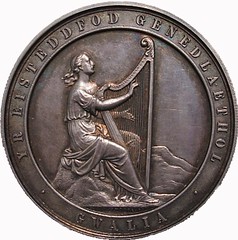
PREV ARTICLE
NEXT ARTICLE
FULL ISSUE
PREV FULL ISSUE
MEDALLIST JOSEPH MOORE
Charles forwarded an extract from Leonard Forrer's "Biographical Dictionary of Medallists" concerning Joseph Moore. Thanks! Here's an excerpt.
-Editor
MOORE, JOSEPH (Brit.). Medallist of the second half of the nineteenth century, born at Birmingham, 17 February 18 17, died there in 1892. His father had served in the Peninsular War and met with a serious accident when the future Engraver was yet a child. At ten years of age he persuaded his parents to allow him to try to earn his own living; he entered the office of a then well-known silver- smith, and while there he learned drawing under Henry Follet Osier. His next step in life was when he was apprenticed tor eight-and- a-half years to Thomas Halliday, a die-sinker, of Newhall Street, nearly opposite to Little Charles Street. His training with Halliday was most valuable to him. In starting business for himself he began with dies for button making, which at that time was one of the chief, if not the greatest, industry of the town. Joseph Moore, at the Exhibition of 1851, was awarded the prize for excellent workmanship in the manufacture of buttons.
When eighteen years of age he for a short time was under the tuition of Samuel Lines, in whose school have been taught so many talented engravers and die-sinkers. In 1844, it was suggested to Moore that he might make a coin which would be an improvement on the heavy and cumbersome penny-piece which was then in currency. He designed a model penny — absolutely his own idea — of about the size of a farthing, inside the raised rim of which was a small piece of silver which brought its value up to the proper standard. The rim was ingeniously devised with the object of making the penny distinguish- able from other coins of a similar size in the pocket merely by feeling it. There was an enormous demand for these tokens; so great, indeed, that Wyon, the coin die-sinker to the Mint, when he came to consult Moore about his system of making dies so that they would not break, good-humouredly explained that they had met with such favour with the public that he had been compelled to advertise the fact that they were the result of private enterprise and not a Government issue.
For more information, or to order, see:
THE BOOK BAZARREWayne Homren, Editor The Numismatic Bibliomania Society is a non-profit organization promoting numismatic literature. See our web site at coinbooks.org. To submit items for publication in The E-Sylum, write to the Editor at this address: whomren@gmail.com To subscribe go to: https://my.binhost.com/lists/listinfo/esylum All Rights Reserved. NBS Home Page Contact the NBS webmaster 
|
